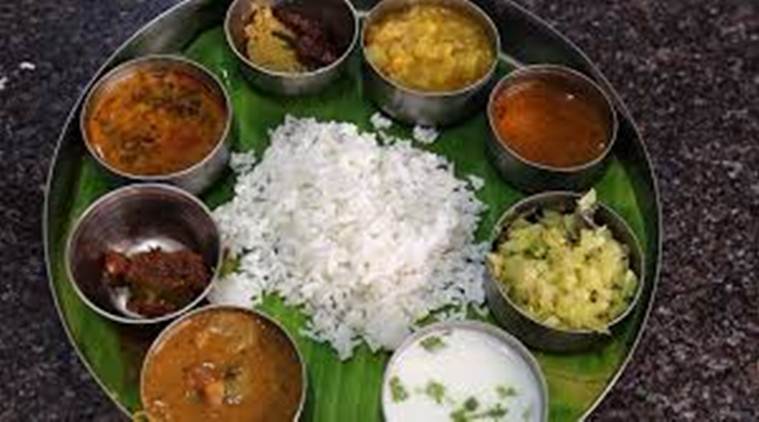Thalinomics in times of rising prices: Veg, non-veg thalis more affordable, says Eco Survey
by PTIBy: PTI | New Delhi | Published: January 31, 2020 10:24:14 pm

As per the survey, a vegetarian thali comprises a serving of cereals, ‘sabzi and dal’ and the non-vegetarian thali comprises of cereals, sabzi and a non-vegetarian component. (Representational Image)
Rising inflation may have burnt a hole in common man’s pocket but Finance Ministry’s chief economic advisor believes otherwise as he brought a novel ‘thali’ concept to otherwise heavy-duty data crunching to drive home the point that affordability of a plate of meal has improved.
Calling it ‘Thalinomics’, Krishnamurthy V Subramanian compared price of standard veg and non-veg meal plates across the country to say that affordability as a factor of daily wage has improved overtime, indicating improved welfare of the common person. Union Budget 2020 | Follow LIVE updates
The affordability of vegetarian ‘thalis’ improved by 29 per cent while that of non-vegetarian by 18 per cent between 2006-07 and 2019-20, the Economic Survey said in its chapter ‘Thalinomics — The Economics of a Plate of Food in India”.
The conclusion has been drawn after analysing the data from the Consumer Price Index for industrial workers for around 80 centres in 25 states/Union Territories from April 2006 to October 2019.
As per the survey, a vegetarian thali comprises a serving of cereals, ‘sabzi and dal’ and the non-vegetarian thali comprises of cereals, sabzi and a non-vegetarian component.
“Both across India and the four regions – north, south, east and west – we find that the absolute prices of a vegetarian thali have decreased since 2015-16 though it increased during 2019. This is owing to significant moderation in the prices of vegetables and dal from 2015-16 when compared to the previous trend of increasing prices,” the survey said.
In fact, the increase in prices of pulses and vegetables contributed to the increase in the thali price during 2019-20 (April-October).
“If the prices of a vegetarian thali had followed the trend obtained till 2015-16, an average household comprising of five individuals would have had to spend Rs 10,887 more on average per year for eating minimum two healthy thalis a day. In other words, after 2015-16, the average household gained Rs 10,887 per year on average from the moderation in thali prices,” the survey said.
Similarly, an average household that eats minimum two healthy non-vegetarian thalis per day gained around Rs 11,787 on average during the same period.
“As another benchmark, we examine an industrial worker’s ability to pay for two Thalis a day for his/her household of five individuals. Using this measure, we find that affordability of vegetarian thalis has improved over the time period from 2006-07 to 2019-20 by 29 per cent and that for non-vegetarian thalis by 18 per cent,” it said.
Comparing between 2006-07 and 2019-20 (April-October), vegetarian thali has become more affordable in all states under consideration. In the case of non-vegetarian thali, affordability has increased during this period in all states except Bihar and Maharashtra, where it has shown a marginal decline.
In 2019-20 (April-October), the most affordable thali was in Jharkhand as two vegetarian thalis for a household of five in the state required about 25 per cent of a worker’s daily wage. Non-vegetarian thali was also the most affordable there.
The survey claimed that 2015-16 could be considered as a year when there was a shift in dynamics of thali prices.
Many reform measures were introduced since 2014-15 to enhance the productivity of the agriculture sector as well as efficiency and effectiveness of agricultural markets for better and more transparent price discovery, the survey said.
In terms of vegetarian thali, the survey found that, an individual who would have spent around 70 per cent of his/her daily wage on two thalis for a household of five in 2006- 07 is able to afford same number of thalis from around 50 per cent of his daily wage in 2019-20 (April to October).
Similarly, the affordability of non-vegetarian thalis has also increased as percentage of wages required decreasing from around 93 per cent to around 79 per cent between 2006-07 and 2019-20 (April to October).
“We have taken the quantities for cereals, vegetables, pulses and non-vegetarian items for each thali assuming that at least two full meals would be consumed in a day such that the daily dietary requirements for these elements would be met,” the survey said.
Vegetarian thali consists of a serving of cereals (300 grams), vegetables (150 grams) and pulses (60 grams). In the calculation, two cereals rice and wheat have been taken. Potato, onion and tomato have been taken as the staple vegetables while brinjal, cabbage, cauliflower and lady’s finger have been taken as the additional vegetables.
For non-vegetarian dish, prices of eggs, fish (fresh) and goat meat have been taken, which are generally consumed across regions as well as religions. In the case of non-vegetarian thali, dal is replaced by non-vegetarian component (60 grams).
Other commodities include spices and condiments used in preparation of the vegetable and dal recipes. Mustard oil, groundnut oil, and coconut oil have been taken, depending on the state-wise differences in the type of oil used for cooking. For fuel, cooking gas prices as well as firewood prices have been taken for which the data is available consistently.
For all the latest Business News, download Indian Express App